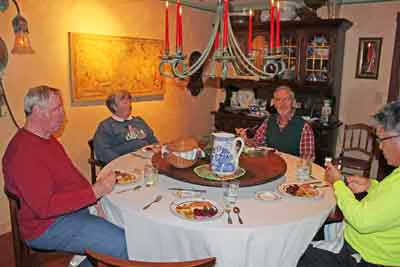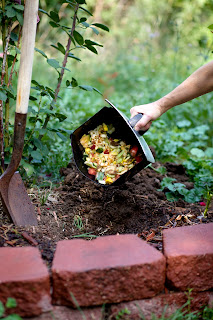 |
| Overhead view of part of our garden. |
A passion for plants can have unintended consequences. For example, I've been fortunate to live on the this wonderful farm for 34 years. During that time I have improved, expanded and embellished the garden. I've built raised beds, put in gravel pathways, added a gazebo and arbors, and added tons of compost. All of that in order to keep planting new, rare, unusual and fun plants.
For example, I was among the first to grow
and blog about ghost peppers, 6 years ago. I was growing green pepper basil and achocha before anyone for many states around even knew what those plants were. I've grown the remarkable Dancing Tea Plant, curry tree, green pea eggplant and Dragon's Claw millet, all out of a passion for seeing and tasting new plants. Over time my love for new plants has grown beyond the bounds of what I can manage. There aren't enough hours in the day to grow, till, weed, photograph and write about all of my plant experiments. So more than a decade ago, we have been hosting interns to help out with the garden.
Over the years we've had a wonderful variety of interns come to our garden. We worked first with a non-governmental organization which provided interns for 9 month stretches. Eventually we changed to working through the
WWOOF organization (Willing Workers on Organic Farms). It's a world-wide organization and gives wonderful opportunities for those wanting to learn about a variety of farming or gardening techniques. This garden year we've hosted 2 WWOOFers, each for 6 week periods.
 |
| Anthony |
Anthony came to us from Pennsylvania in early April after working on a farm in Virginia. He arrived just in time to help with the garden clean-up, tilling and bed preparation. He had not planted a garden before so learning about seed depth and spacing were his first lessons.
He's also an adventurous cook and lover of hot sauces, so while he was here, he worked with me in the kitchen, learning to make homemade crackers and hot sauces. Because of his background of working in a pizza place, he had a feel for working with flour and within a few days, had perfected crackers, making more beautiful and crispy crackers than I had in the past. (Recipes from my book,
Easy Homemade Crackers Using Herbs).
 |
| A few of Anthony's crispy crackers. |
Anthony left us in mid-June right after our annual garden open house and headed for Las Vegas, NM, where he worked on a farm until the fall. He stopped to visit us for a day and night on his way back to Pennsylvania where he will work the winter then return to WWOOFing on farms next summer.
Our next intern who also quickly became a good friend, is Charles. We were his first WWOOFing farm and he was eager to learn every aspect of farm life. He took over the daily chores with the goats and chickens and learned the process of making goat cheese and yogurt.
 |
| Charles |
Charles also had a love for hot sauce and since we're growing 40 varieties of hot peppers this year, I quickly put him to work learning how to make and can hot sauce (recipes from my newest book,
Make Your Own Hot Sauce). We also canned tomatoes, something he'd not done before. Josh taught him about sourdough bread making and Charles quickly learned that, as well.
Charles is a vegetarian, not because he dislikes meat, but because he really likes vegetables, so I took on the challenge of learning to be a better vegetarian cook. Our interns fix some of their own meals in the guesthouse kitchen, but lots of our meals are combined, especially at dinner time. I really enjoyed learning new recipes and finding ways to have balanced-protein meals without meat. I was surprised that I didn't crave meat and went much of the 6 weeks Charles was here, eating no meat.
 |
| Charles playing guitar and singing. |
Charles has an excellent singing voice and entertained us several evenings with singing and playing the guitar. He and Anthony had both been in bands and they got to meet when Anthony made his stop-over on his way home.
 |
| Josh, Charles and Anthony, discussing the affairs of the world. |
So, even though our garden has grown far beyond what I can take care of myself, it has opened up opportunities for interns to come and learn from me. I feel very fortunate to have these amazing young people (not all young, either, WWOOFers can be of any age) come to stay with us, learn about cooking with herbs, planting vegetables, tending animals and cooking good food.
Almost without exception, the interns we've had over the past 10 or 12 years, have been passionate about food, eager to grow their own, thirsty for knowledge and willing to share what they know, as well. I admire them for their willingness to take risks, do new and interesting things and discover what they want to do in life. I feel as if I learn more than they do, each one bringing something new and interesting with them. Here are a few more of our interns from previous years.
 |
| Kristin |
 |
| Paul the pie man |
 |
| Adam, who has been back 3 times working. |
 |
| Yakof Smirnoff, with intern, Gabe |
 |
| Seth, who came by bicycle, and mastered cracker making, too. |
Each person who came as strangers, left as friends. Each has contributed their talents and ideas and made our lives better by their sharing journey of discovery with us. I feel so very fortunate to have the opportunity to know and learn from each person who comes to our garden.



















































